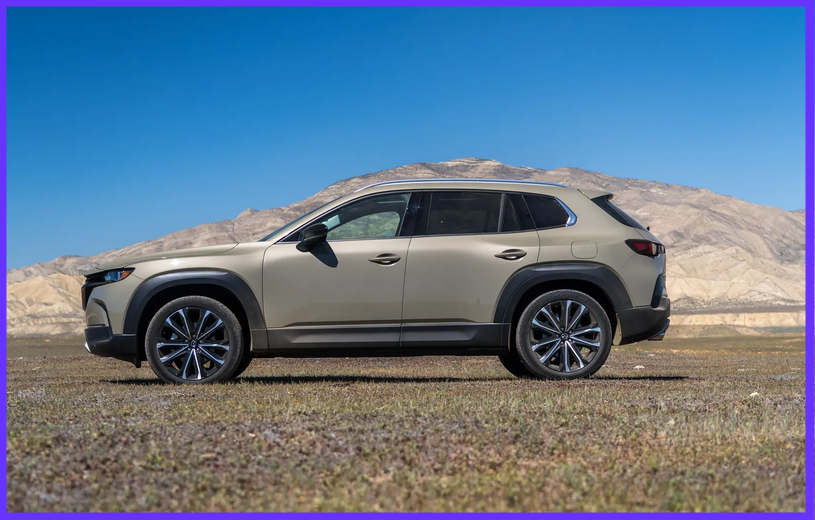2023 MAZDA CX-50 Release date, Reviews & Pricing, Mazda aims to produce a better Subaru Outback by marketing the CX-50 to off-road enthusiasts, but in doing so, it may have rendered its own CX-5 outdated.
You’d be excused for assuming that the new 2023 Mazda CX-50, which debuted late last year and will be available in showrooms this spring, is the replacement for the company’s most popular model, the CX-5. However, the automaker has taken the odd decision to present the two crossovers, which are similarly sized and priced, as contemporaries. It’s difficult to imagine that sales won’t be cannibalised by this somewhat larger and tougher-looking CX-50 chowing down.
After a day behind the wheel on twisty Southern California roads and some gravel paths that are probably more difficult than what the CX-50’s target consumer will ever encounter, I’m persuaded that this is a very different car from the urbane CX-5. It may happen also be just what Mazda needs to compete with more outdoorsy competitors.
2023 MAZDA CX-50 Specifications
2023 Mazda CX-50
Vehicle Type: front-engine, all-wheel-drive, 4-door, 5-passenger wagon
PRICE
Base: 2.5 S, $28,025; 2.5 Turbo, $37,625; 2.5T Premium Plus, $42,775
ENGINES
DOHC 16-valve 2.5-liter inline-4, 187 hp, 186 lb-ft; turbocharged DOHC 16-valve 2.5-liter inline-4, 256 hp, 320 lb-ft
TRANSMISSION
6-speed automatic
DIMENSIONS
Wheelbase: 110.8 in
Length: 185.8 in
Width: 75.6 in
Height: 63.5-63.9 in
Passenger Volume: 98-100 ft3
Cargo Volume: 31 ft3
Curb Weight (C/D est): 3710-3910 lb
PERFORMANCE (C/D EST)
60 mph: 6.2-8.0 sec
1/4-Mile: 14.8-16.4 sec
Top Speed: 125 mph
EPA FUEL ECONOMY
Combined/City/Highway: 25-27/23-24/29-30 mpg
Leaner, meaner chassis
The CX-50 may appear to be a CX-5 version, but it is really based on a newer platform shared with the CX-30 and the most recent Mazda3. The CX-50 is 6.7 inches longer bumper to bumper and 3.1 inches wider shoulder to shoulder when parked next to the CX-5. The extra breadth is highlighted by a 2.2-inch lower roofline than its sibling and a more sinister blacked-out version of Mazda’s winged headlight and grill pair. The CX-50’s side mirrors sit inboard of its shoulders, which means it’s around 2.5 inches narrower when measured mirror-to-mirror, which could come in handy when squeezing into small areas.

The CX-50, which is accented with black plastic cladding around its lower body and wheel arches, also has about an inch more ground clearance than the CX-5, measuring 8.3 inches for the S versions and 8.6 inches for the Turbo. That puts it on par with comparable soft-roaders like the Subaru Outback (8.7 inches) and the more expensive Audi A4 Allroad (7.0 inches). The dimensions of the CX-50 are likewise more akin to those tall waggons than Mazda’s other more upright SUV.
The larger footprint of the CX-50 translates into increased inside space, including a larger rear cargo floor than the CX-5 and more legroom for second-row passengers. When equipped with Mazda’s first panoramic moonroof, the lower overall height makes loading and unloading the roof rack easier but also reduces headroom, leaving the CX-50 with only 38.6 inches up front (down 1.1 inches vs. CX-5) and 37.5 inches on the second row (down 1.5 inches).
Specifications Compared
| 2023 Mazda CX-50 | 2022 Mazda CX-5 | 2022 Subaru Outback | |
| Wheelbase | 110.8 inches | 106.2 inches | 108.1 inches |
| Length | 185.8 inches | 179.1 inches | 191.3 inches |
| Width | 75.6 inches | 72.5 inches | 73.0 inches |
| Height | 63.9 inches | 66.1 inches | 66.1 inches |
| Ground clearance | 8.6 inches | 7.5 inches | 8.7 inches |
2023 MAZDA CX-50- 2.5-liter Skyactiv-G engines
Mazda’s 2.5-liter Skyactiv-G inline-four-cylinder engine is available in two variants for the CX-50. S versions with naturally aspirated engines produce 187 horsepower and 186 pound-feet of torque. On 93-octane premium fuel, turbo models feature a twin-scroll turbocharger, increasing output to 256 hp and 320 lb-ft. Fill up with cheaper 87-octane fuel, and output reduces to 227 horsepower and 310 lb-ft, which is still a respectable level of power and perhaps not a bad tradeoff given current fuel prices.
When weaving up a twisting mountain road, the CX-50’s broader stance and lower centre of mass contribute to a more grounded feel than the already terrific and exciting CX-5, allowing the turbocharged engine to shine more when it comes time to accelerate out of a turn. This engine has enough of power for passing on straight stretches, from the natural and snappy throttle tip-in to the linear distribution of torque throughout the tachometer’s swing.
Both types, however, have separate fuel-saving technologies: the naturally aspirated CX-50 S uses cylinder deactivation technology to sip fuel at an EPA estimated average of 24 city mpg, 30 highway mpg, and 27 combined mpg. Turbo variants, which are slightly thirstier, feature a stop-start anti-idling system and are predicted to return 23 city mpg, 29 highway mpg, and 25 combined mpg. In either case, a well-behaved six-speed automatic transmission is standard, as is Mazda’s i-Activ all-wheel drive.
Powertrain Specifications
| Mazda CX-50 S | Mazda CX-50 Turbo | Subaru Outback | Subaru Outback XT | |
| Engine | 2.5-liter I4 | 2.5-liter turbo I4 | 2.5-liter H4 | 2.4-liter turbo H4 |
| Horsepower | 187 hp | 256 hp | 182 hp | 260 hp |
| Torque | 186 lb-ft | 320 lb-ft | 176 lb-ft | 277 lb-ft |
G-Vectoring Control and MI-Drive Select
The Mazda Intelligent Driving Select or MI-Drive drive modes, which can be toggled between Normal, Sport, Off-Road, and Towing modes with the flick of a small switch on the centre console, allow the CX-50’s performance to be tailored to the task at hand. The four modes don’t feel all that different from one another without adaptive suspension, but Mazda says that’s by design; its drive mode philosophy is that the CX-50 should feel like the same vehicle with the same driving dynamics, with the modes silently adapting for changing conditions.
Normal is the default setting for balanced performance, while Sport wakes up the powertrain with increased throttle response and transmission programming changes to keep revs higher and longer in the powerband. (This setting also prohibits mid-corner downshifts, which could throw the CX-50’s balance off or slow down exit speeds.) Sport mode also has a more liberal all-wheel-drive torque distribution, giving more power to the rear when accelerating and completely cutting rear axle torque when cornering to avoid understeer. This option also employs Mazda’s G-Vectoring Control handling technology more aggressively.
Off-road and Towing modes
The CX-50’s Off-Road mode seeks to imitate the traction and feel of asphalt when driving on dirt and gravel paths. It accomplishes this by making even more aggressive use of GVC to assist the front wheels in digging into looser substrates and by transferring more torque to the back axle to aid in cornering stability. The transmission and brake-based traction-control system are also tweaked to improve low-speed grip, and the CX-50 can recognise when it’s pointed uphill and alter the idle speed to prepare for a climb.
The dirt prowess of the CX-50 in both Normal and Off-Road modes. The minor differences between the two settings combine enough to make a noticeable impact on the path. Off-Road mode, in particular, smoothed out my steering inputs, necessitating less little twitches and corrections to keep the SUV oriented in the right direction. The added ride height won’t turn the CX-50 into a rock crawler, but the extra clearance and approach angle will give you peace of mind when navigating difficult terrain.
There are no programmes for rocks, sand, or ruts, and there is no crawl help. There is no slope descent control, and there is only one Off-Road mode. Mazda authorities claim that custom terrain modes take too long to activate and work inconsistently. They argue that all you actually need is a sturdy, easy-to-modulate brake pedal. To its credit, the CX-50 made light work of climbing up some very steep ascents. Descending a similarly sloppy, steep gradient, on the other hand, felt more like a barely controlled slide, with the anti-lock brakes trying to keep the speed under control.
Mazda Connect infotainment
The cockpit of my Turbo Premium Plus model is attractive in its simplicity, due to easy climate controls, a satisfying-feeling steering wheel, and firm, supportive leather seats. A typical 7-inch instrument cluster display isn’t overburdened with information and looks terrific when accompanied by a set of tactile gauges.
The Mazda Connect infotainment system, on the other hand, is a mixed bag. The majority of CX-50 trims include a 10.3-inch centre display that is controlled by a tactile knob and buttons on the centre console (base models drop down to an 8.8-inch screen). If you keep to Mazda’s onboard navigation and music sources, the system is simple to comprehend and use, owing to its bare bones design and simple, sparse menus.
Things become more tricky if you wish to use regular wireless Android Auto or Apple CarPlay. The central display is a touchscreen, but only when one of these phone mirroring methods is used. However, the screen is so deep in the dashboard that reaching it without leaning forward is impossible. Worse, when the vehicle is in motion, the touchscreen feature is disabled. Using the physical controller to navigate these interfaces is quite strange, as it can be impossible to predict where the pointer will travel when the knob is twisted or nudged. It is a really unsatisfactory experience.
Standard driver aid tech
The majority of the driver-assist technology in the 2023 CX-50 is standard. Lane departure warning and lane keeping assist, blind spot monitoring, automatic emergency braking, and adaptive cruise control that works in stop-and-go traffic are all included. Moving up to the top Turbo Premium Plus model adds rear automatic brake assist and front and rear parking sensors, as well as Mazda’s Traffic Jam Assist – an enhanced version of the company’s hands-on steering assistance and adaptive cruise control technologies that provides more precise lane centering and smoother stop-and-go operation when traffic speeds fall below 40 mph.
2023 MAZDA CX-50 Price and competition
The CX-50 2.5 S starts at $28,025 including the $1,225 destination charge, which makes it somewhat higher than the CX-5 ($27,125) but in line with the standard $28,320 Subaru Outback. The CX-50 Turbo starts at $37,625, but my Turbo Premium Plus example costs $42,775 when equipped with $395 Zircon Sand Metallic paint. This Mazda is slightly more expensive than a Subaru Outback Touring XT ($41,320) with comparable equipment.
Yes, the CX-50 is probably too near to the CX-5 in Mazda’s range, and I wouldn’t be surprised if this model eventually replaces its smaller sibling in a few years, but for now, this is a very different-feeling vehicle when you look beyond the numbers. More importantly, the CX-50 combines Mazda’s hallmark excellent on-road driving dynamics – where you’ll do 95 percent of your driving – with trail capability that rivals off-road-focused competition like the Outback and Audi’s A4 Allroad, making this 2023 Mazda CX-50 a very compelling addition to Mazda’s lineup.






